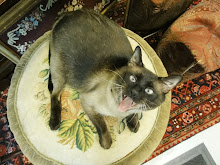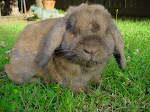
Now that we have Joe on the road to recovery, we're faced with another ailment, BUMBLEFOOT. All the chickens except one has it, even Joe. We're only at stage one with Joe, J.D. and two of the other girls. Pumpkin is at stage two of Bumblefoot.
Here's a great explanation from...
http://www.firststatevetsupply.com/
BUMBLEFOOT
By: Peter J. Brown, First State Veterinary Supply, Inc.
I field many calls over the course of the year concerning that large bulbous growth on the bottom of the chickens foot. Bumblefoot as it is called is usually caused first by an abrasion to the skin of the foot pad and then an infection sets in causing the large growth on the bottom of the chickens foot. It doesn’t have to be a wide open cut just a small scrape or light abrasion to the foot pad will be enough to cause a problem. Most cases of bumblefoot involve the following bacteria: Staphylococcus aureus, E.coli, Corynebacterium spp., and Pseudomonas spp. Once the infection takes hold in a matter of days the foot and or foot pad becomes swollen and is somewhat reddened and may be hot to the touch. The above mentioned bacteria that cause Bumblefoot are extremely aggressive and can and do infect humans. You would be wise to handle these birds with latex rubber gloves and be sure to wash your hands and change and wash your clothes before handling healthy birds.
Bumblefoot is preventable for the most part. Make sure that all roost poles or roosting areas are free from sharp objects such as,nails, screws,broken glass,jagged metal edges or other sharp objects that may cause an injury to the foot or foot pad. Make sure roost poles are not to high for the birds to jump down from so that they wont injure their feet or legs and cause an infection to get started. Even a rough roost pole can be enough to cause enough injury to the foot pad of the right bird and start a case of Bumblefoot. Over weight birds may be more susceptible as bearing excess weight on the foot pad together with a rough surface to stand on may cause injury to the foot pad and allow an infection to get started. Concrete floors can also be a problem if a bird is allowed to spend a lot of time on one or in an area where there are a lot of sharp edged stones.
The key to treating Bumblefoot is to catch it early. If the foot is swollen but is still soft to the touch you will stand a very good chance of curing the problem with antibiotics alone. If the foot swells and goes unnoticed generally the swollen area will become as hard as a rock and no amount of antibiotics will take the swelling completely away. The only alternative at this point will be surgery. Surgery can be successful if done carefully and properly. Antibiotics should be give for 5 to 7 days before surgery and until the surgical area is healed. Before beginning surgery the entire foot area and lower leg should be throughly washed and cleaned. Disinfect the area with a controlled iodine solution. Do not use pure iodine as it will burn the tissue and make the bird real uncomfortable and will slow the healing process. You can use a numbing agent such as ambesol to partially numb the area before making your incision. Make your incision with a new scalpel and just go slowly and avoid any tendons and blood vessels and slowly make your incision across the affected area making sure that you keep the incision as small as possible. Control bleeding with blood stop powder and by applying finger pressure to the upper part of the leg. Remove all of the hard pus material from the incision and flush it out with saline solution then apply some triple antibiotic ointment directly into the wound and suture or use gauze and adhesive tape to close the wound. It will heal faster and stay cleaner if the bird is not allowed to directly stand on the surgical area. In this case a cast can be made from just about any material that you may have around the house. Be innovative as long as it doesn’t add to the problem. In some cases a halved tennis or racquetball attached to the foot will do the trick. Change the dressing on the foot daily for the first week and then every other day or so as long as the wound is healing well.
If you are treating with antibiotics and not doing surgery the antibiotics of choice would be the following: Lincomycin 50 to 100 mg per bird per day for 7 to 10 days,or Doxycycline 50 to 100 mg per bird per day for 7 to 10 days,or amoxicillin at the rate of 250 mg per bird per day for 10 to 14 days and in some cases 500 mg per bird per day may be necessary but give it twice per day for 10 to 14 days. Cephalexin capsules work well in soft tissue and should be given at the rate of one 250 mg capsule once or twice per day for 7 to 10 days. After successful treatment all birds should receive probiotic in the drinking water for 7 to 10 days or until droppings return to normal.
"Farm livin' is the life for me."




















No comments:
Post a Comment